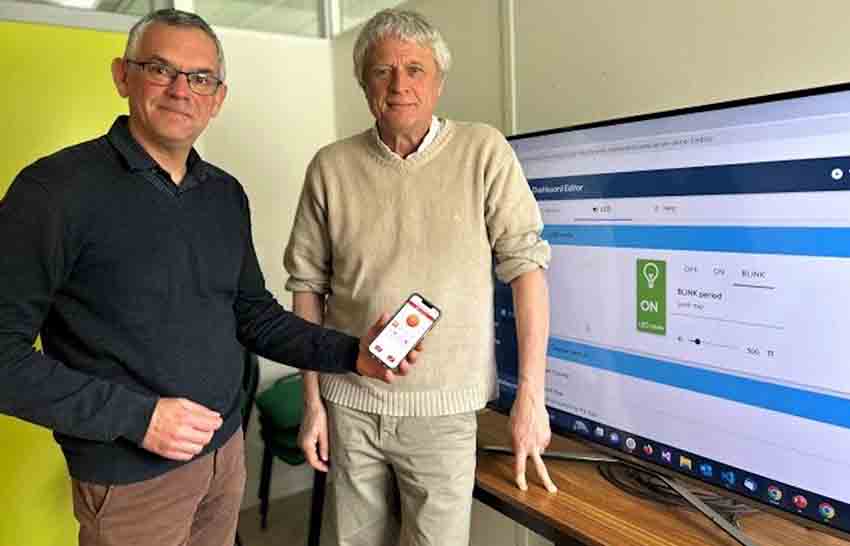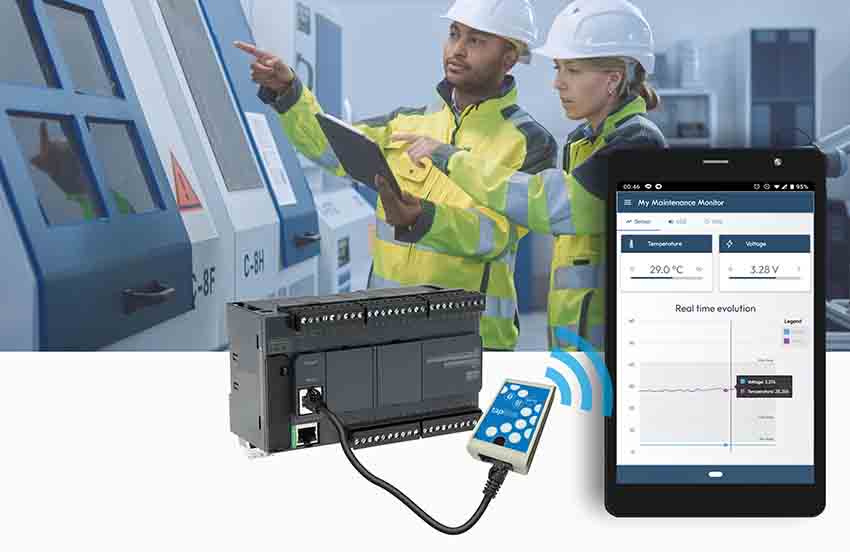Companies that are creating connected products and systems are faced with a complex landscape of IoT technologies – wireless, networking, cloud, security etc. IoTize provides them with a no-code solution that overcomes this complexity, eliminates risks and shortens time-to-market of their IoT-enabled products.
Their hardware/software solution takes the form of wireless modules, and a no-code tool ecosystem. The wireless modules pre-implement everything that’s required for IoT connected products and systems. If any customization is needed, IoTize’s modules include a java virtual machine that allows adaptation to the most specific data handling or cloud requirements with just a few lines of java code.
The company’s IoT wireless solution is used by customers producing home appliances and with systems for HVAC, industrial automation and energy distribution.
Easy Engineering: Which are the most futuristic products / solutions from your portfolio?
IoTize: The most futuristic part of our solution today is IoT App Creator. This user interface (or UI) design environment is the latest addition to our tool ecosystem. It leads today’s no-code design trend by providing a WYSIWYG, drag-and-drop environment for creating a UI for any electronic appliance or system.
IoT App Creator allows any designer to create a UI that can run as a mobile app, or in a browser on a PC. So, the UI can be used on mobiles connected directly to a system, or as dashboard for remote supervision of a system.
No coding is required to create a rich, contemporary, professional UI. Even designers who have never created a UI, or a mobile app, can do it with IoT App Creator.
Getting started is extremely easy. Designers just import the configuration of their IoTize wireless module into IoT App Creator. They instantly see data from their design or system in a simple numerical display. The required data flow mechanisms are created automatically by our tool.
Initially, designers just drag-and-drop graphical components like charts, gauges, and buttons, into the UI display. Designers focus on creating and organizing the UI. They don’t worry about writing the code to create graphical components or the layout.

For experienced designers who want more flexibility, IoT App Creator provides several options.
First is the Data Flow Editor. It allows designers to manipulate the variables that are displayed in the UI. There they can do mathematical conversions (ex. convert Celsius to Fahrenheit), calculate a new parameter based on two variables, or combine variables in the same chart. Designers can even define changes to graphical components such as changing the color from green to red as a warning when data values reach a specific level. The Data Flow editor is a logic diagram that is very easy to use. Designers drag-and-drop functional nodes and link them to the graphical components of their UI. No coding is required to use them.
Designers can also add their own graphics in SVG format, add their own code (HTML, java), and create their own libraries of graphical components and add them as plug-ins.
Finally, IoT App Creator works with our automatic App Generator to create Android and iOS apps. When designers are satisfied with their UI, they just send the UI configuration to App Generator. The generator provides them an app to test on mobile phones and a project to sign and build into the final app for publication.
IoT App Creator’s no code approach makes UI creation accessible to everyone who is involved in creating IoT-enabled product or systems.
E.E: Tell us about the company’s long-term goals / prospects?
IoTize: Our long-term goal is simply to transform the simple idea that was at the core of our solution into a global business. The simple idea was to facilitate the creation of connected devices by pre-implementing features and thus eliminating the need for coding and wireless design. Today 2 things favor the expansion of our business: there is a acceleration in the creation of IoT devices and the “no-code” approach is really taking hold among design engineers.
E.E: Tell us about product innovation and how it impacts the future?
IoTize: Necessity is the mother of inventions, right? But, where product innovation begins with the person who is faced with the necessity, that person often does not have the expertise or the tools to invent their solution.
At IoTize, for the past 6 years we have been creating an innovative solution to a host of challenges that we know companies face in creating connected devices. This innovation eliminates challenges, eliminates risks and accelerates their own innovations.
That acceleration is crucial to the value of our innovation in the future. Cycles of change will only become shorter. Companies will have less time to respond to client needs and market changes. Wasting time and accepting unnecessary risks to redo what has already been done is folly. It is the assurance that companies will fail.
E.E: What’s moving your company forward?
IoTize: This view, that innovation should improve accessibility to technology is moving us forward. When we started, our solution addressed a specific market of embedded systems developers – people who are used to circuit design and coding.

Today, with the last release of our Tap Manager app with its adaptable HMI, and our new IoT App Creator, we’re bringing this solution to a much wider audience in industry. Users in machine design, facilities management, and even installation and maintenance technicians can easily use our solution.
Finishing IoT App Creator and expanding our lines of industrial products enhances our offer for industrial retrofit. This expands our market potential and puts our products on a much shorter decision cycle with industrial customers.
E.E: How do employees shape your company’s future?
IoTize: Having a generic solution like ours is an accomplishment, but finding the applications and market sectors where it is most advantageous is another challenge. Employees don’t just bring us their skills, they bring us their world experience, and that’s where the applications are.
For example, our initial focus was on components, embedded systems and designers. It was an employee who introduced us to industrial electronics and various types of programmable controllers and components. He was even able to put together some rapid Proofs-of-Concept on an industrial protection relay. That was the spark that led us to create our first industrial products.
Today, those industrial products: TapBus, Tapioca and TapNPass are a huge benefit to industrial technicians and system designers who don’t or can’t work and the embedded level writing and debugging code. In terms of business, these products offer us a great opportunity for rapid sales. And all that started with an employee’s experience and knowledge of a specific industry.
E.E: How does the digital transformation affect your products / business?
IoTize: Very simply, our industrial products place us at the core of the digital transformation.
As companies move to improve their processes and decision making, they need to connect legacy and new systems to supervisory platforms and to technicians. They can’t completely, overnight re-invent manufacturing, building, electrical, and other infrastructure. They need a solution for retrofit of legacy infrastructure that may remain in place for decades to come. They need that solution to be easy to implement and to adapt easily to future technological evolutions. This is exactly what our solution offers them today.
E.E: Tell us about research and development in your company.
IoTize: IoTize is 80% engineering and R&D. Since our inception in 2017, we have grown our expertise from embedded systems and wireless design, to encompass security, mobile devices, and the cloud.
Our engineering team has worked with partners to keep abreast of technologies in these areas, partners that have included STMicroelectronics, Gemalto (now Thales). Much applied R&D inspiration also comes from the field and from customers that have included Schneider Electric and Air Liquide. These and others have provided insights that have guided our solution ensuring its adaptability to the needs of different applications and markets.
IoT App Creator Introduction video
E.E: Tell us about the company’s future strategies and how will you adapt to the future.
IoTize: Our strategy is first to maintain and develop our no-code / low-code approach. Today we have a very robust and complete no-code resource – our lwM2M engine. It has everything you need in a connected device. This is combined with an embedded Java Virtual Machine – the low-code resource which gives us versatility. With the JVM, very little code allows our customers to add communication protocols, handle any cloud platform, drive all sorts of add-on components. With a little java code, most customers will find the flexibility they need to adapt to the most specific needs.
The second part of our strategy is based on the fact that we know we are asking designers to change the way they work – to get away from coding and trust our code. This has advantages in speed of implementation, reactivity to market needs, reduction of risk. Helping them understand the advantages is crucial and requires dedicated, expert partners who take the time to understand their needs and show them a solution that they probably didn’t expect. We’re growing that network now, with representatives in as many countries as possible, to be accessible and talk directly with our customers.
The third part of our strategy is to focus, as I said on the software and bring this to the hardware of our partners – component designers, module designers, and even OEM manufacturers of subcomponents for specific types of appliances or equipment. Our software is available under license and we provide our certified hardware designs as wireless reference designs. Our expertise is not in the logistics and manufacturing of electronics devices. This will allow our solution to reach more application markets and more geographic markets.
E.E: How do you think the future will look like in your field of activity?
IoTize: We’ve made a large investment in the no-code approach to design, because we expect this tendency to boom. Software designers are already faced with enormous diversity in technologies and needs for expertise combined with very short development cycles. The evolution of AI for coding will eventually create additional pressures towards acceleration. This creates an unrelenting pressure towards code-reuse and the no-code approach to design.
Designers will move away from the line-by-line coding to areas where they have a crucial value… that value is their understanding of the human user, the user’s environment, challenges and needs. The no-code approach will allow them to focus on these human aspects of innovation and respond more rapidly, in progressive iterations.

